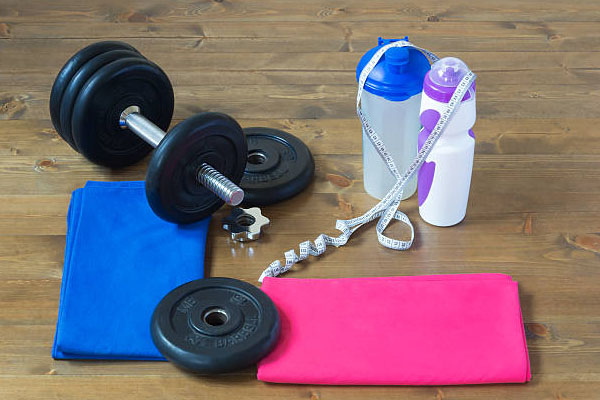Discover the numerous advantages of cross-training in sports Explore how it enhances performance, reduces the risk of injuries, and improves overall fitness Get expert insights and tips to elevate your athletic journey
Cross-training in sports, often referred to as the practice of incorporating a variety of physical activities into an athlete's training regimen, offers a multitude of advantages. Whether you're a seasoned athlete or someone looking to improve their overall fitness, cross-training has the potential to transform your athletic performance and well-being. In this article, we'll explore the diverse benefits of cross-training, from enhancing performance and reducing the risk of injuries to improving overall fitness. We'll also delve into how to incorporate cross-training effectively, create structured schedules, track progress, and answer common questions surrounding this dynamic training approach.

Benefits of Cross-Training in Sports
Enhanced Performance
Cross-training in sports offers a range of benefits, and one of the most significant advantages is the enhancement of athletic performance. By engaging in a variety of activities and exercises, athletes can experience the following performance improvements:
1. Improved Strength and Conditioning: Cross-training allows athletes to target different muscle groups and movement patterns. This diversity in training helps build overall strength and conditioning, contributing to enhanced performance in their primary sport.
2. Enhanced Endurance: Engaging in activities like swimming or cycling alongside their primary sport can boost an athlete's cardiovascular fitness. This increase in endurance can translate to greater stamina and improved performance during competitions.
3. Injury Prevention: Cross-training helps athletes address muscle imbalances and weaknesses. As a result, it reduces the risk of overuse injuries and strain related to repetitive motions commonly associated with single-sport training. An injury-free athlete is more likely to perform at their best.
4. Agility and Flexibility: Incorporating activities such as yoga or agility drills can enhance an athlete's flexibility, balance, and agility. These skills are often transferable to their primary sport, helping them react quickly and move efficiently on the field or court.
5. Mental Toughness: Cross-training introduces new challenges and experiences. Athletes learn to adapt to different training environments, which can improve their mental resilience and ability to stay focused under pressure during competitions.
6. Varied Movement Patterns: Different sports and exercises require unique movement patterns. By diversifying their training, athletes develop a broader range of motor skills that can benefit their primary sport. This adaptability can be a significant performance advantage.
Cross-training isn't just about building physical strength; it's also about developing a well-rounded athlete. The improved strength, endurance, agility, and mental resilience gained through cross-training can give athletes a competitive edge and help them reach their full potential in their chosen sport.
Reduced Risk of Overuse Injuries
One of the significant benefits of cross-training in sports is the reduced risk of overuse injuries, which can be detrimental to an athlete's performance and overall well-being. Here's a closer look at how cross-training helps mitigate the risk of overuse injuries:
1. Balanced Muscle Development: Cross-training involves a variety of activities that engage different muscle groups. By regularly switching between sports and exercises, athletes ensure balanced muscle development. This reduces the strain on specific muscle groups that can lead to overuse injuries in their primary sport.
2. Reduced Repetitive Stress: Overuse injuries often result from repetitive movements that stress particular joints and muscles. Cross-training introduces diverse movements, lowering the constant strain on the same body parts. For example, a runner who cross-trains with swimming or cycling can give their running muscles a break while still staying active.
3. Enhanced Recovery Time: Cross-training can be a valuable tool for active recovery. Athletes can engage in activities that are less intense on certain days to allow their bodies to recover from the strain of their primary sport. This approach helps prevent chronic overuse injuries from developing.
4. Improved Flexibility and Mobility: Incorporating flexibility and mobility exercises into cross-training routines can reduce stiffness and improve joint mobility. This, in turn, reduces the risk of strains and sprains associated with inflexible joints.
5. Mental Break from Monotony: Overuse injuries aren't solely physical; they can also result from the mental strain of repetitive training. Cross-training introduces variety and novelty into an athlete's routine, reducing the mental monotony and stress that can contribute to overuse injuries.
6. Early Detection and Prevention: Cross-training allows athletes to detect early signs of overuse injuries more easily. If they experience discomfort or pain during a different activity, they can address the issue before it becomes a full-blown injury, preventing extended downtime.
By incorporating cross-training into their regimen, athletes can reduce the risk of overuse injuries, thereby prolonging their careers and enhancing their overall performance. The combination of diverse physical activities and improved recovery strategies creates a robust defense against the harmful effects of overuse.
Improved Overall Fitness
Cross-training in sports is a highly effective strategy for improving an athlete's overall fitness. It encompasses a wide range of physical activities and exercises that contribute to enhanced fitness levels in various aspects:
1. Cardiovascular Health: Cross-training often involves aerobic activities such as running, swimming, or cycling. These exercises promote cardiovascular health by increasing heart rate and improving circulation. Better cardiovascular fitness leads to increased endurance and stamina.
2. Strength and Muscle Development: Incorporating strength training and resistance exercises, like weightlifting and bodyweight workouts, as part of cross-training routines enhances muscle strength and development. Strong muscles contribute to better physical performance and reduce the risk of injuries.
3. Flexibility and Range of Motion: Many cross-training activities, including yoga and Pilates, focus on improving flexibility and joint mobility. Enhanced flexibility increases the range of motion, preventing stiffness and supporting injury prevention.
4. Improved Core Stability: Core strength is crucial for stability and balance in sports. Cross-training exercises often target the core muscles, strengthening the abdomen, lower back, and pelvis. A strong core provides better posture, balance, and injury resistance.
5. Agility and Coordination: Cross-training activities that involve agility drills, like agility ladder exercises or plyometrics, enhance an athlete's agility, coordination, and reaction time. These skills are vital in sports that require quick and precise movements.
6. Mental Wellness: Cross-training is not only about physical fitness; it also promotes mental well-being. The diversity of activities can reduce workout monotony and prevent burnout. Athletes often experience reduced stress levels and improved mental focus.
7. Body Composition: Engaging in a variety of exercises helps athletes achieve and maintain a balanced body composition. Cross-training can aid in weight management, muscle toning, and fat loss, ultimately contributing to an athlete's overall fitness.
Improved overall fitness achieved through cross-training not only benefits an athlete's performance in their primary sport but also enhances their general health and well-being. The combination of cardiovascular conditioning, strength development, flexibility, and mental wellness creates a well-rounded approach to fitness that's beneficial both on and off the field.
How to Incorporate Cross-Training
Choosing Complementary Activities
When incorporating cross-training into your sports regimen, selecting complementary activities is essential. These activities should align with your primary sport and help you achieve specific fitness goals. Here's a closer look at how to choose complementary activities effectively:
1. Consider Your Primary Sport: Start by considering the demands of your primary sport. If you're a runner, for example, you may want to choose activities that improve cardiovascular fitness and leg strength, such as cycling, swimming, or hill sprints.
2. Identify Weaknesses: Assess your weaknesses as an athlete. Are there areas in which you could improve? For instance, if you lack upper body strength, incorporating activities like weightlifting or rock climbing can be beneficial.
3. Match Intensity and Duration: Ensure that the intensity and duration of your complementary activities align with your primary sport's requirements. If you're a long-distance cyclist, your cross-training activities should focus on endurance and sustained effort.
4. Prevent Overlapping Movements: Avoid choosing cross-training activities that overly mimic the movements of your primary sport. This can lead to overuse injuries. For example, if you're a tennis player, consider swimming or yoga to diversify your movements.
5. Incorporate Variety: Variety is key to effective cross-training. Don't limit yourself to just one complementary activity. Rotate through different options to work on multiple fitness aspects and prevent workout boredom.
6. Set Clear Goals: Define clear fitness goals for your cross-training activities. Whether you aim to improve your core strength, agility, or flexibility, having specific objectives will guide your choices and track your progress.
7. Consult a Coach or Trainer: If you're unsure which activities are best suited for your primary sport, consult with a coach or trainer. They can provide expert guidance based on your individual needs and goals.
Choosing complementary activities for cross-training is an integral part of maximizing its benefits. The right selection can enhance your performance in your primary sport, help you address weaknesses, and reduce the risk of overuse injuries. Whether you're a professional athlete or a fitness enthusiast, strategic cross-training can elevate your athletic journey.
Cross-Training Schedules
Creating an effective cross-training schedule is crucial to maximize the benefits of incorporating diverse activities into your sports training regimen. Here's how to structure a well-balanced cross-training schedule:
1. Define Your Training Goals: Start by clarifying your fitness and performance goals. Understand what you aim to achieve with cross-training. Whether it's injury prevention, improved endurance, or overall fitness, your goals will shape your schedule.
2. Assess Your Primary Sport Schedule: Consider your primary sport's training and competition schedule. You need to ensure that your cross-training activities complement rather than interfere with your primary sport commitments.
3. Weekly Frequency: Determine how many days per week you can dedicate to cross-training. For most athletes, 2-3 days of cross-training is a good starting point. This allows for recovery and avoids overtraining.
4. Activity Selection: Choose the cross-training activities that align with your goals and weaknesses. Balance cardiovascular, strength, and flexibility exercises based on your specific needs.
5. Balanced Workouts: Ensure that each cross-training session offers a balanced workout. For example, if you're cycling, mix in hill climbs, intervals, and flat rides to work on different aspects of your fitness.
6. Rest and Recovery: Incorporate rest days into your schedule. Overtraining can lead to fatigue and injury. Rest days are essential for recovery and regeneration.
7. Periodization: Consider periodization, which involves changing the intensity and focus of your cross-training activities throughout the year. This approach helps prevent plateaus and keeps your training fresh.
8. Monitoring Progress: Regularly assess your progress. Keep a training diary to track improvements in strength, endurance, and other fitness aspects. Adjust your cross-training schedule as needed based on your results.
9. Consult a Coach or Trainer: Seek guidance from a coach or trainer to fine-tune your cross-training schedule. They can help you set realistic goals and create a structured plan that aligns with your specific sport and fitness objectives.
By carefully planning your cross-training schedule, you can ensure that it complements your primary sport training, targets your weaknesses, and helps you achieve your desired fitness outcomes. A well-structured schedule enhances your overall athletic performance and minimizes the risk of overuse injuries.
Tracking Progress
Monitoring and tracking your progress during cross-training is essential for ensuring that you are on the right path to achieve your fitness and performance goals. Here's how to effectively track your progress and make data-driven decisions:
1. Establish Baseline Measurements: Start by establishing baseline measurements for key fitness parameters. This could include your starting weight, body composition, endurance levels, strength, and flexibility. Knowing where you begin allows you to measure progress accurately.
2. Keep a Training Journal: Maintain a training journal to record each cross-training session. Include details like the type of activity, duration, intensity, and how you felt during the workout. This journal can help you identify patterns and trends in your training.
3. Set Short-Term and Long-Term Goals: Define specific, measurable, and time-bound goals for your cross-training. These goals could relate to improved endurance, increased strength, weight loss, or enhanced flexibility. Setting both short-term and long-term objectives provides motivation and direction.
4. Regular Assessments: Schedule regular assessments or evaluations to gauge your progress. These assessments may include fitness tests, body measurements, or performance evaluations. Perform these assessments at intervals that make sense for your goals, such as monthly or quarterly.
5. Use Technology: Embrace technology to track your progress. Fitness apps, wearable devices, and online platforms can help you monitor metrics like heart rate, calories burned, and distance covered. These tools provide real-time data and historical records for analysis.
6. Consult a Professional: Consider seeking guidance from fitness professionals or trainers. They can conduct comprehensive assessments and provide expert insights to fine-tune your training routine.
7. Adjust Your Plan: Analyze the data collected during your cross-training and use it to make informed decisions. If you're not progressing as desired, be prepared to adjust your plan. This might involve modifying your workout intensity, trying new activities, or reevaluating your goals.
8. Celebrate Milestones: Celebrate your achievements and milestones along the way. Recognizing and rewarding your progress can boost motivation and maintain a positive outlook on your fitness journey.
9. Be Patient: Understand that progress may not always be linear. Plateaus and setbacks can occur. Stay patient and committed to your training, and continue to track your progress to identify areas for improvement.
Effective progress tracking is a critical component of successful cross-training. By collecting and analyzing data regularly, you can make informed decisions, adjust your training plan as needed, and work toward achieving your fitness and performance objectives. This data-driven approach will help you stay motivated and see tangible results from your efforts.
FAQs about Cross-Training in Sports
Q1: What is cross-training, and how does it benefit athletes?
A1: Cross-training involves engaging in a variety of physical activities and exercises to improve overall fitness and athletic performance. It benefits athletes by reducing the risk of overuse injuries, enhancing strength and conditioning, and promoting mental resilience.
Q2: Can anyone benefit from cross-training, or is it primarily for elite athletes?
A2: Cross-training is beneficial for individuals of all fitness levels, not just elite athletes. It can be tailored to meet specific fitness goals, whether you're a professional athlete or someone looking to improve their general fitness and well-being.
Q3: How do I choose the right complementary activities for cross-training?
A3: To choose complementary activities for cross-training, consider your primary sport, identify weaknesses, match the intensity and duration of activities, prevent overlapping movements, incorporate variety, set clear goals, and consult with a coach or trainer for personalized guidance.
Q4: What should my cross-training schedule look like, and how often should I cross-train?
A4: Your cross-training schedule should align with your primary sport commitments, include a balanced mix of activities, incorporate rest days, and consider periodization. Most athletes find that cross-training 2-3 days per week is a good starting point.
Q5: Why is it important to track progress during cross-training, and what tools can help with monitoring?
A5: Tracking progress is crucial for assessing the effectiveness of your cross-training efforts. It helps you make data-driven decisions, adjust your plan, and stay motivated. Tools like training journals, fitness apps, wearable devices, and professional assessments can assist in monitoring your progress.








